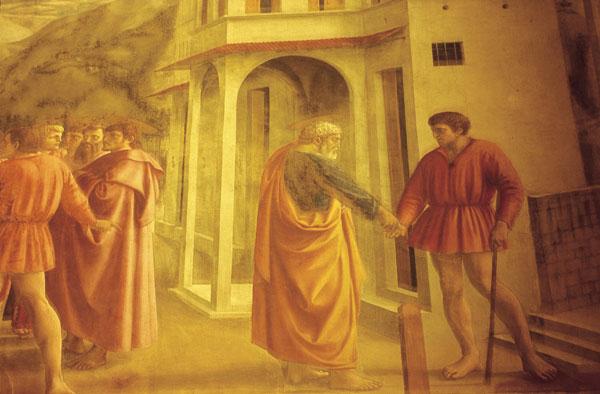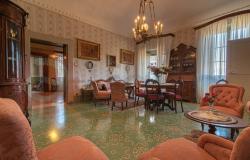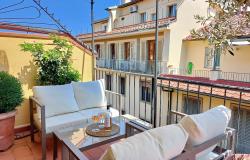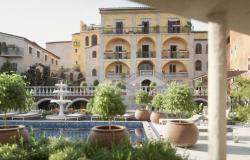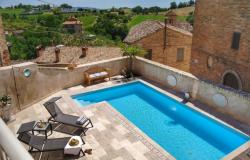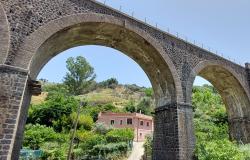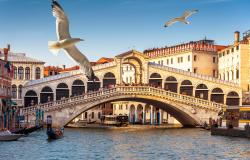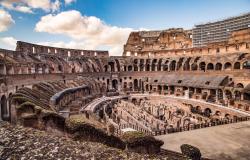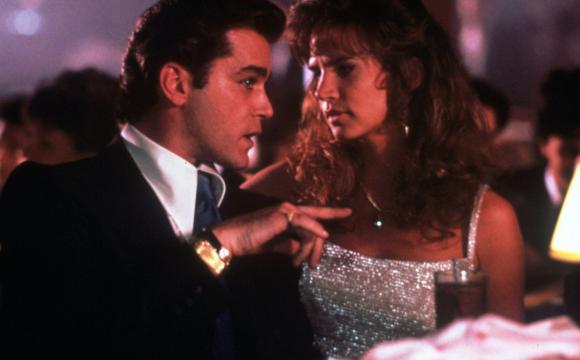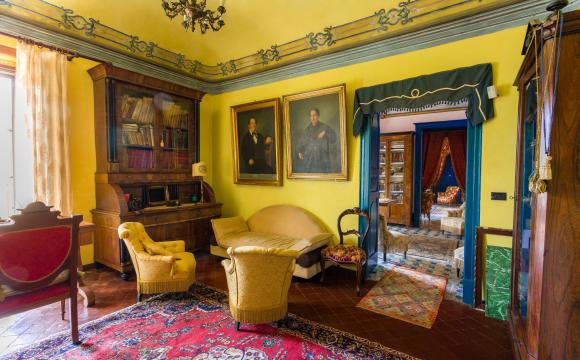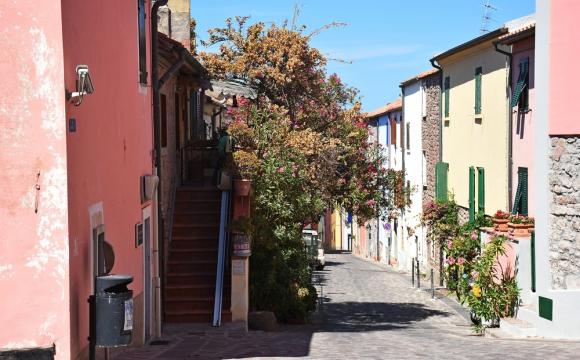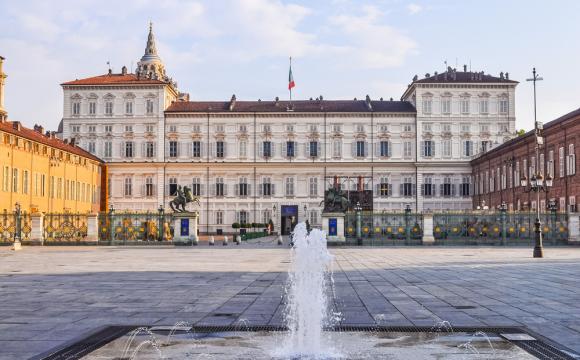The origins and dating of the Renaissance are still debated by scholars though most now agree that the paintings of Giotto and Duccio, and the sculptures of Nicola Pisano and his son Giovanni, form a useful starting point. The Pisano sculptures are a clear revival of the classical form, while the realism of Giotto and Duccio represent a break with the stiffness of Byzantine paintings.
But though Giotto’s paintings are far removed from the static art of his predecessors he had not solved the problems of representing a three- dimensional world on a two-dimensional surface or of lighting his subjects. Within a century these problems had been solved by three Florentines whose influence on their successors was profound. Brunelleschi, with his theoretical work on perspective and the existence of a vanishing point, and Donatello, the master sculptor, are well-known names, but too often the genius of the painter Masaccio is overlooked.
Tommaso di Ser Giovanni de Monte was born in 1401 at San Giovanni Valdarno. By the age of 16 he had moved to Florence where, within two years, he had established a reputation as a talented artist. By 1425 he had begun his most famous works. By 1428 he was dead, the formidable, innovative series of paintings of his last few years representing both a massive step forward in technique and serving as an inspiration to later artists.
Light and Perspective
Giorgio Vasari, whose Lives of the Artists is such a repository of information on the Renaissance, explains that Tommaso was an ‘absent-minded and careless person’, his clumsiness being the origin of the nickname Masaccio - clumsy Tom - by which he is now known. According to Vasari, Masaccio had little interest in wealth, often not bothering to pursue those who owed him money, concentrating all his efforts into his art. Of that very little remains, a dozen or so pieces scattered around the world, but the two most important works remain where they were executed, in Florence. The first is in the church of Santa Maria Novella, less visited than some other Florentine churches because it lies a little away from the main tourist route and in a less distinguished part of the city. The Trinity, a fresco on the wall of the north aisle, is a masterpiece of perspective, so much so that legend has it that when it was revealed to the Florentines many did not at first believe it was a painting, seeing instead a sculpted Crucifix hanging in front of a new chapel. The architectural features of this ‘virtual’ chapel with its delightful barrel roof owe much to works by Brunelleschi and Donatello. As well as being a superb exercise in perspective, the fresco is organised around the original lighting sources of the work, one of which, a doorway into Via degli Avelli, has now been blocked. One interesting curiosity of the work is Adam’s skeleton lying on a sarcophagus beneath the Crucifixion. Written in Tuscan dialect above the skeleton is ‘I was what you are, you will be what I am’ a rather stark intimation of mortality.
About 150 years after its completion the Trinity was concealed from view when an altar and altarpiece were placed in front of it. It remained hidden for almost 300 years, only being revealed again when the altar was moved. The fresco was then relocated, but replaced in its original position in 1952.
Mastering Emotion
Parts of Masaccio’s other great masterpiece, the fresco series in the Brancacci chapel of Santa Maria del Carmine, across the Arno from the main city sites, were also hidden from view for some time. Here though, the reason was not a change to the layout of the church, but the 17th-century prudery that added fig leaves to his Adam and Eve in the Expulsion from the Garden of Eden. The leaves were removed a century or so later. The figures of the expulsion show another side of Masaccio, a willingness to portray raw emotion which, until his time, had been notably absent from the painter’s repertoire. In a break with tradition Adam is shown holding his head in grief while Eve, eyes closed, is shrieking an agonised cry. The figures are also human-like rather than idealised, the influence of Donatello’s sculpture on Masaccio being equally apparent in The Tribute Money, the Baptism of the Neophytes and St Peter Healing the Sick with his Shadow in each of which the sturdy figures are realised almost sculpturally. In the latter work, many experts believe that the man in the red cappuccio (15th-century Florentine headwear) is Donatello himself. Brunelleschi’s influence is also apparent: in The Tribute Money the vanishing point of the house on the right of the painting is behind Christ’s head, drawing the spectator’s eye to the most important element of the work. Those three panels - the Brancacci panels all depict scenes from the life of St Peter - and the ‘Expulsion’ are the only ones in the chapel that are indisputably Masaccio, the rest being by Masolino or Filippino Lippi, or perhaps by combinations of the three artists, and all show the young men’s mastery of emotion. Look at the puzzlement on the face of St Peter as the serene Christ indicates where the tax collector’s money may be found in The Tribute Money. In the Baptism a figure waiting for baptism shivers in the cold, while the kneeling neophyte flinches from the shock of the freezing water which soaks his hair. In the Healing, which is set in a typical Florentine street of Masaccio’s time, the hopelessness of the sick and the surprise of the healed are tangible.
Masaccio was just 27 when he died. In terms of surviving works his legacy was small, but in terms of the Renaissance and the history of art it was profound.
